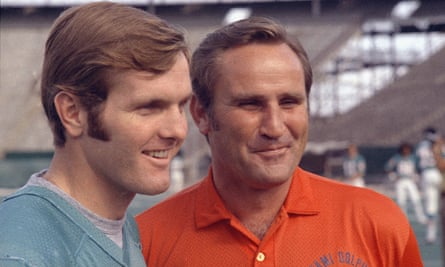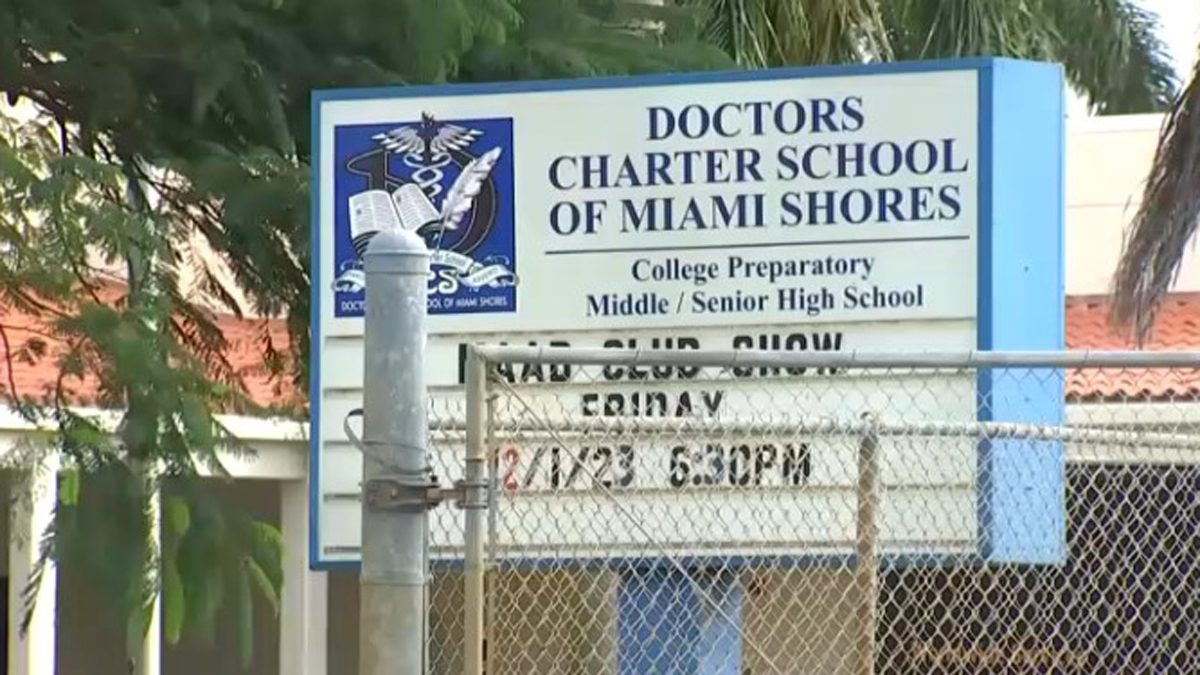50 years on, the 1972 Miami Dolphins’ undefeated season remains undefeated | Miami Dolphins

It’s been 50 years since the 1972 Miami Dolphins became the first (and, so far, only) team in NFL history to win every game in a season. For many who played on the Dolphins that year, it’s hard to reconcile the passage of time with the immediacy of the memories. “Fifty years is a long time ago,” laughs Dick Anderson, the Dolphins’ Pro Bowl safety in 1972, but it “feels like it was yesterday.”
It’s useful to quickly clarify one aspect of the ’72 Dolphins’ achievement – for a finicky reason, the phrase “perfect season” (rather than “undefeated season”) is often used to describe the campaign. Although ties are uncommon in today’s game, they were once relatively prevalent. In the 1920s, four teams technically finished their seasons ‘undefeated,’ although each of them finished with at least one draw. As such, the Dolphins’ lossless and tieless 1972 season remains unique in NFL history. The league itself has acknowledged the team’s peerless performance – the ’72 Dolphins were judged to be the greatest team in NFL history during the league’s centennial celebrations in 2019.
Despite such recognition, it’s become fashionable to minimize the ’72 Dolphins’ accomplishments. Critics argue that the Dolphins faced a weak regular season schedule that year. Although true, the idea that their schedule was the major factor in the team’s success doesn’t stand up well to scrutiny. In addition to the obvious counterpoint (ie, the ’72 Dolphins are far from the only team in NFL history to face a weak schedule, but they are the only team with a perfect record), football’s infatuation with data makes it possible to outline the team’s greatness via statistics, weak schedule or not.
The Dolphins didn’t just win every game in 1972 – they did so in a historically well-rounded manner. The Miami offense scored more points and gained more yards than any other team that year. Meanwhile, their defense restricted opponents to both the fewest points and the fewest yards in the league. No other team in NFL history has ever led the league in points and yards, on both sides of the ball, and won the championship in the same year.
To focus on the numbers, however, is to overlook the anecdotes and memories that are the building blocks of any legendary endeavour. For example, one persistent urban legend foisted upon the ’72 Dolphins is that the team’s surviving members gather for a champagne toast each season when the last remaining undefeated team loses. Although it’s not true, like many myths the story has roots in reality.
“It started because Bob Griese, Nick Buoniconti and I all lived on the same street,” says Anderson, referring to two of his Hall of Fame teammates, “and whenever the last team got beat, we’d go get a bottle of champagne to celebrate.” Anderson clarifies that the celebrations quietened down when Griese and Buoniconti moved away from the street, but that it still “puts a big smile on your face when the last [undefeated] team loses a game.”
The team-wide champagne toast may be a tall tale, but there are enough true stories surrounding the team’s perfect season to justify its status in NFL history. Take Dolphins punter Larry Seiple’s famous 37-yard run on a fake punt in the AFC Championship game against the Pittsburgh Steelers.
“Playing Pittsburgh in Pittsburgh wasn’t an easy deal,” says Seiple. “The week before we even went to Pittsburgh, we looked at it and realized … there’s a chance to be able to run, if necessary, for a first down because of the way [the Steelers defended] their punt returns.” There was, however, one caveat – head coach Don Shula (another Hall of Famer) instructed Seiple to go for the fake punt only if instructed to do so from the sideline.
“Well, I got a little antsy and took off on my own,” says Seiple. “It was just one of those things, in the heat of the action – [the gap in the defence] was so wide open, my grandmother could have run through it … I couldn’t help myself. The only thing I was thinking about was making the first down. If I hadn’t made it, I’d probably still be walking home from Pittsburgh – Shula wouldn’t have let me on the plane.”
Conversations with Seiple and other members of the team also reveal how different life in the NFL was 50 years ago. Many mention feeling an intense sense of camaraderie with other players in the 1970s, a sentiment they perceive to be diminished, or even absent, from the modern game where big money has changed how teammates interact. Offensive lineman Doug Crusan, for example, lived with multiple teammates in an oceanside house just north of Miami throughout the 1972 season. He and his teammates even carpooled to practice together.
“You really got to know each other, you shared stuff,” says Crusan. “We always had a spot that we had to stop at a couple times a week on the way home. You’re sitting there, you’re drinking a beer – there was a lot of togetherness.”
Living with teammates, however, wasn’t an exercise in teambuilding. It was a financial decision – the salaries were also very different 50 years ago.
“[The money I earned from] those two games, the AFC championship and the Super Bowl, was more than my salary,” says Crusan, who received $8,500 and $15,000 for each game, respectively. The smaller salaries back then meant that many players on the ’72 Dolphins had second jobs. Crusan worked at an NGO in the offseason while Seiple was in a PR role for the Dolphins. Anderson sold insurance not only in the offseason, but on the Mondays after games during the season (“My coaches didn’t like that,” he recalls).
The differences aren’t just off the field – the way the game itself is played has also been transformed. Describing the on-field changes to his position over the last half-century, Crusan says, “The glaring difference is the way they pass block, versus what we were allowed to do. They are allowed, now, to extend their arm straight out, almost like doing a bench press. Our arms couldn’t be greater than a 45° angle … you really had to tie up close with another player. We had much more – I’ll call it “pugil contact” – where everybody could pound each other.”
Larry Little, Crusan’s Hall of Fame colleague on the offensive line (yes, yet another Hall of Famer), has similar sentiments. “They hold every play now … they could call a holding play on every play in every game [nowadays] if they wanted to,” he says.

“And, there’s a lot of fat guys out there now, too,” he adds with a laugh. “There’s a lot of ‘belly bumping’ out there. I was big then, but I wasn’t fat.”
Little credits his coach for encouraging him to stay fit. “Shula made me lose weight when he came to Miami,” he says. “It helped me a lot … in this sweltering heat down here in Miami, I could play a whole game without getting tired.”
Little isn’t the only member of the team to speak fondly of his former coach (Shula died in 2020 at the age of 90. Many members of the ’72 Dolphins helped throw him a surprise 90th birthday party a few months before his death). Indeed, reverence toward Shula is widespread among the ’72 Dolphins.
“I never learned a thing about football until that first year at Miami,” says Charlie Babb. “Studying football under Don Shula. I mean, lights and bells go off with the way [Shula and his staff] handled and studied the game.”
A 22-year-old rookie safety, Babb was the youngest player on the ’72 team. He took what he learned in film sessions with Shula and, like Seiple, produced a momentum-shifting play of his own to help protect the Dolphins’ perfect record.
He successfully blocked a punt against the Cleveland Browns in the first round of the playoffs, returning it for the only touchdown of his career, an exciting play for any player but especially a rookie. “My mother and father were at that game and, when I did block that punt and scored that touchdown, my mom claimed she peed in her pants.” Even on a team with multiple Hall of Famers, it was timely plays from Babb, Seiple, and others that proved crucial in creating a legacy that still exists today.
“It’s the most alive team I’ve ever been affiliated with – I think that anyone’s every been affiliated with – because it’s still competing,” explains Larry Csonka, the team’s Hall of Fame fullback. “Each year we come back to life. It’s us against [the undefeated team of the current season].”
Csonka is probably the most famous member of the ’72 team. To many younger fans, he’s best known for being possibly the only player in NFL history to be penalized for unnecessary roughness while carrying the ball (Csonka laughs when remembering the play, “Shula was not real happy with it … he grabbed me by the shirt and started shaking me.”) Despite his star power, however, Csonka refuses to dominate the limelight surrounding the Dolphins’ perfect season.
“There’s a unity that goes on with the ’72 team,” he says. “It was all of us. Charlie Babb stepped forward, Larry Seiple stepped forward … they made the difference on a matter of one or two or three plays, [and those plays] made the difference in the season. That’s how finite that gets. That’s how competitive that is, to be able to say that you’re the number one team in the history of the league, the only one that went from game one to the championship and won them all. It’s a thing you’re more proud of because it reflects teamwork, not just a few stars.”
Even 50 years later, the camaraderie of the ’72 Dolphins is alive and well.

:quality(70)/cloudfront-us-east-1.images.arcpublishing.com/cmg/SF4IORSMBZDJZLRNHLPOPS2XFU.jpg)
